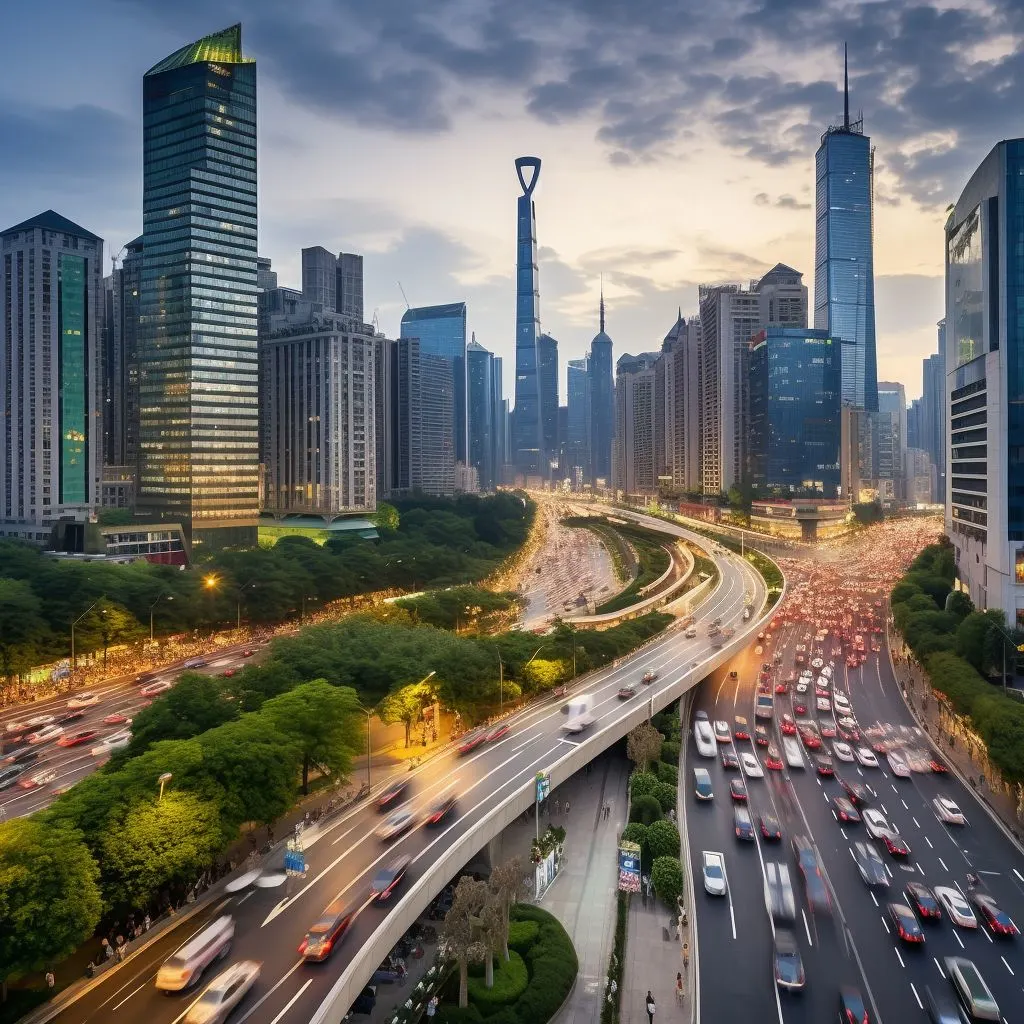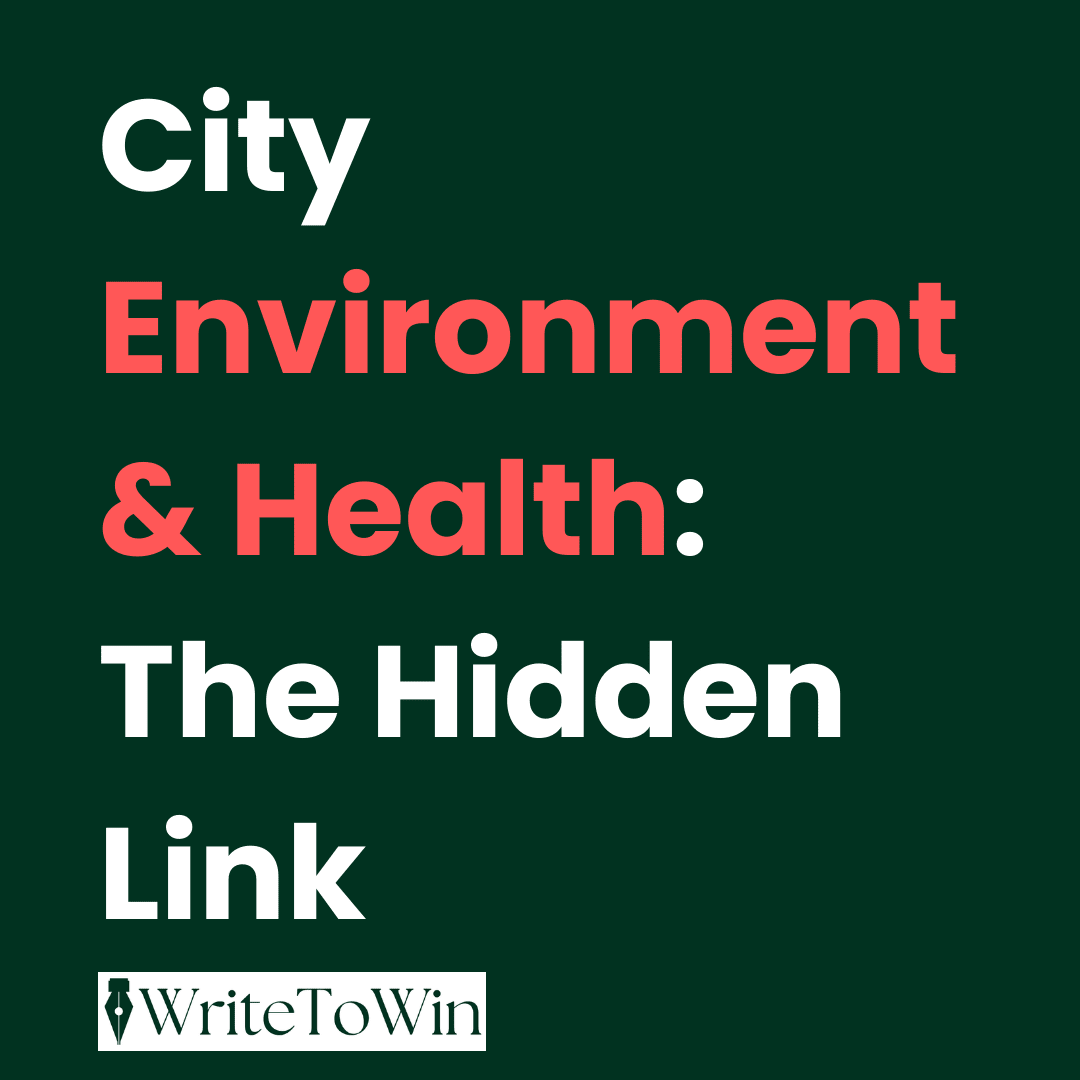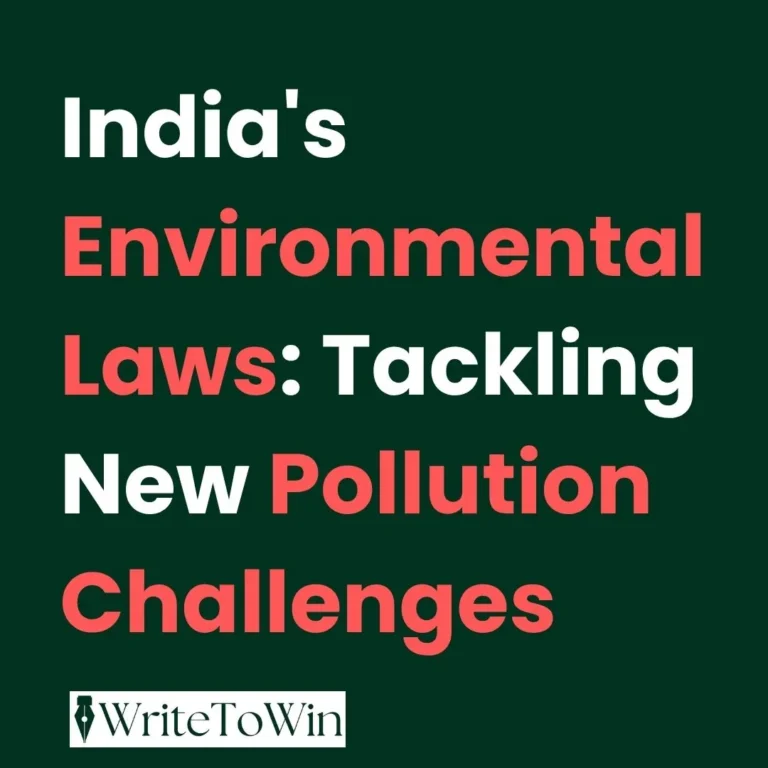1. Introduction
Urban ecosystems are dynamic interactive systems where determinants in the environment affect health all at once. It is what we breathe (air), drink (water), see/cover otherwise (green cover), and hear (soundscape) that determines the trajectory of health of dwellers. A environment & health is key to protecting and improving human physical and mental wellbeing.
Environmental stressors build up and get loaded disproportionately on socially and physically disadvantaged groups in rapidly urbanizing environments—South Asia as a whole.
Physical outcomes like respiratory disease or water-borne disease are comparatively easily measurable with environmental etiology, whereas mental health outcomes (stress, sleep disturbance, eco-anxiety) are unmeasurable but no less real.
Pathways and outcomes of environmental degradation in health are discussed here, Indian case studies are presented, and solutions are suggested in an integrated manner.

2. Conceptual framework: environmental pathways to health
The environmental determinants operate on a range of, sometimes cross-over, pathways:
- Direct exposure routes: inhalation of tainted air (SO₂, NOx, particulate matter), ingestion of tainted water (heavy metals, pathogens), and dermal contact with tainted water or soil.
- Indirect physiological stressors: noise pollution raises stress hormones, heat islands raise cardiovascular stress, crowding and dirt raise infectious disease transmission.
- Psychosocial mechanisms: unavailability of green space and residence in deteriorating neighborhoods exacerbate mental well-being, social connections, and feelings of belongingness—leading to depression, anxiety, and eroded resilience.
- Socioeconomic mediation: housing, labor, and poverty exposures add to exposure by limiting adaptive capacity (e.g., for clean fuel, cooling, or medical care).
- Purchasing these routes allows for policy intervention across sectors: environmental protection is preventive public health.
3. Synthesis of the evidence: environmental stressors and health outcomes
3.1 Urban air pollution: an important urban health risk
Ambient air environmental pollution is the largest environmental risk factor for morbidity and mortality worldwide. Causal relation to cardiopulmonary disease, stroke, lung cancer, and birth has been established with exposure to fine particulate matter (PM2.5). Ambient and indoor air pollution resulted in millions of deaths worldwide in the recent past, indicating its size as a public health issue.
In Indian cities in general and in India, PM2.5 levels are elevated relative to international guideline values. Seasonal maxima—associated with meteorological inversions, biomass combustion, and high emissions—correlate with increased emergency presentations with cardiovascular and respiratory disease. National government large area reporting and surveillance, for instance, give mean unhealthy air maxima in the National Capital Region with obvious time correlations with health-service use.
Ultrafine particles may penetrate deep lung alveoli and be translocated into systemic circulation and cause systemic inflammation, endothelial dysfunction, and pro-thrombotic state—mechanisms for increased risks of myocardial infarction and stroke during pollution.
3.2 Chemical and pathogen water contamination: exposures
Urban water supplies are beset by a number of failure points: outfall of untreated sewerage, outfall of industrial effluent, corroded and old pipes in the distribution, and sporadic contamination due to waterlogging or flooding. Urban water pollution leads to diarrheal disease, hepatitis, and chronic toxemia (e.g., arsenic, lead), ultimately affecting child development and chronic disease prevalence.
Delhi’s Yamuna river and urban lakes such as Bengaluru’s Bellandur are the zones of maximum high pollution load of untreated industrial effluent and sewage—i.e., direct public health hazard and indirect psychosocial harm (recreational loss and cultural value). Latest data and reports confirm the high pollution load of river stretches in urban regions.
3.3 Heat islands and heat: climate exposure and morbidity
Urban cities are warmer than surrounding rural areas because of the urban heat island effect: urban heat is reflected and stored off surfaces, and the loss of vegetation reduces evaporative cooling.
Heat waves have direct and hidden health impacts, such as heatstroke, dehydration, acute kidney injury, and cardiovascular mortality—especially among elderly people and those who work outdoors.
The most compelling evidence is Ahmedabad: India’s first municipal Heat Action Plan (HAP) implemented in response to the deadly 2010 heatwave, and subsequently demonstrating it resulted in quantifiable reductions in heat-related mortality after its implementation.
Ahmedabad’s case places low-cost, easy-to-imitate public-health adaptation interventions for hot cities into the evidence base.
3.4 Vectors, waste, and infectious disease
Poor sanitary disposal of solid waste and stormwater runoff provide breeding sites for dengue, leptospirosis, malaria, and chikungunya vectors.
Unsanitary dumps also release harmful gases and particulates when they are burned or anaerobically decomposing—exposing adjacent communities to chronic respiratory irritants and toxic air pollutants.
Scientific research on dumps shows increased respiratory and dermatological morbidity of the people residing in the area and occupational disease risk of waste pickers.
3.5 Open space, social cohesion, and mental health
Contact and outdoor exposure have quantifiable impacts on mental health. Large observational studies validate at least crude two hours a week outdoors to be linked with higher well-being and lower mental illness.
Dose of exposure is a reasonable measure for urban planning use. Loss of environmental green space, restricted use by low-income dwellers, and esthetic perception of environmental deterioration lead to increased stress, reduced social contact, and “eco-despair.”
The psychosocial mechanism is valid: deteriorated environments diminish relief of stress, physical activity, and social integration—factors directly reducing depression and anxiety.
4. Indian city case studies
Four city examples are provided for this sub-section that cover a range of types of environmental-health connections and policy implications.
4.1 Delhi: acute and chronic air-pollution shocks
Delhi’s air pollution has several causes—when motor vehicle exhaust, industrial effluent, dust, biomass burning, and meteorology combine, they drive foul air to new heights.
CPCB, and local monitoring data, document run-of-year events when AQI (PM2.5) shoot to dangerous levels; these are preceded by spikes in hospitalization of respiratory distress, and inhaler medication.
Interventions by the public (school closure, alert warning) follow the path environmental degradation quickly becomes public-health emergency.
- Policy ramifications: Delhi experience is an example of needing harmonised, multi-sectoral response—transport policy (public transport, EV uptake), industrial control, periphery farm residue disposal, and season window intervention for high pollution.
4.2 Ahmedabad: Heat-Action Plan and adaptive public health
The 2010 Ahmedabad heatwave precipitated a disastrous peak in deaths but led to one of India’s earliest climate-health responses: the Ahmedabad Heat Action Plan.
Evaluations record declines in all-cause mortality in following heat summers, with some evidence of pre-warning, public awareness, public air-conditioned shelters, and support to vulnerable members to avoid heat event-related deaths. Ahmedabad’s HAP is a template for other hot cities.
- Policy suggestions: HAPs need to include meteorological forecast, health system readiness, community mobilization, and low-cost cooling interventions among the vulnerable.
4.3 Bengaluru: parks, lakes, and ecosystem services
Bengaluru used to have many lakes and avenue tree spaces that provided microclimate conditions, ground water recharge, and play spaces.
Urbanisation, encroachment, and untreated sewage run-off eliminated most of the water bodies of the city (Bellandur lake’s foamy pollution and frequent fires are a common sight).
Dening park and lake mean less outdoor children’s play space and social space—leading to physical inactivity and poorer mental health.
- Policy issues: restoration of lakes, protection of wetlands, and equitable distribution of parks need to be resolved in an effort to restore lost ecosystem values and values of mental-well-being.
4.4 Mumbai: waste, landfills, and proximate health burdens
Mumbai’s enormous dumps and road-level waste economies produce site-specific levels of pollution with morbidity impacts reported.
Residents of the residential zones of dumping and transfer stations are exposed to chronic smoke (open burning), leachate, and vector contact—conditions associated with high rates of respiratory symptom and other morbidities.
Community case of waste-based illustrates the environmental and occupational injustice that defines urban waste systems.
- Policy implications: decentralisation of waste treatment, promotion of segregated collection and recycling, and legalisation of protection of workers minimize environmental and health damages.
5. Social justice and disproportionate exposure
Environmental risks are socially constructed. The poor will be at the margins of industrial zones, industrial corridors, and dumps; they have less green cover and financial capital to restrain exposures (air cleaners, health care, or migration).
Children, child-bearing women, elderly, and away-from-home occupationally are most disproportionately exposed. Environmental health is not separate from social justice: interventions have to benefit the most exposed and most vulnerable.
6. Policy and programmatic responses: a common agenda
To shatter the causality loop of health and environment, cross-cutting environmental and public health solutions and targets are required. The interventions described are listed in order of optimal implementability and evidence:
6.1 Improve air-quality control
Expand public open dashboards and real-time monitoring networks to the public to inform public behavior and policy.
Include transport reductions (expansion of public transport, low-emission zones, EV incentives), industry reductions (emission control implementation), and domestic reductions (clean cooking fuels).
6.2 Ensure and restore urban water infrastructure
Investment in sewage treatment plants and no industrial effluent discharge.
Restore lake and city wetlands for filtration, recreation, and biodiversity; protect groundwater recharge zones.
6.3 Scale up climate-health adaptation
Heat Action Plans that are local condition-specific—early warning, cooling centers, community mobilization, and protections for outdoor workers. Pilot tested Ahmedabad plan.
6.4 Reform waste management
Institutionalize source segregation, decentralize recycling, composting economies, and campaign against open burning and dumping. Provide health and rights of waste workers through formalization and occupational safety.
6.5 Invest in green infrastructure for equity
Set quantitative targets for per capita green space, priority one for urban tree canopy in hot-spot neighborhoods, and promote green roofs and street trees in new development. Evidence of the nature-mental health relationship underpins these investments.
6.6 Embed environment and health governance
Urban planning must have departments of health as integral stakeholders, and environmental policy must be transparent and equitable in health co-benefits.
Routine health surveillance with environmental exposure data (e.g., hospitalization due to air pollution) must be in place.
6.7 Engage communities and employ citizen science
Public participation (air monitors, water samples) engages the public, holds the citizen body accountable, and bridges monitoring gaps.
Public campaigns can induce behavior change (waste segregation, tree protection, noise reduction).
7. Institutional and legal framework
Indian judiciary’s interpretation of environmental protection as an integral part of the fundamental right to life (Article 21) has facilitated public-interest litigation and environmental jurisprudence. Landmark judicial orders have introduced principles such as the precautionary principle, polluter-pays, and sustainable development—giving juridical cover to a larger-scale action.
Municipal and state level implementation loopholes, institutional fragmentation, and capacity are generally the reason behind policy and court order compliance dilution. Institutional development at the local level, finance, and capacity are the most critical to bridge legal precepts to on-the-ground health dividends.
8. Priorities for research and monitoring needs
Even with compelling evidence for environment-health correlation, there are several issues that need to be monitored and researched at the local level: Longitudinal cohort studies to measure lifetime health outcomes of inner-city early childhood exposure.
Local exposure estimation by high-resolution monitoring to produce intra-city contrasts. Estimation of co-benefit interventions (e.g., how much particulates are abated by a given bus rapid transit line, and what the mortality reduction is the by-product).
Indicators of mental health included in environmental health surveillance to measure psychosocial impacts of degradation and restoration.
9. Conclusion
Environmental health of the city is not secondary but a leading driver of the physical and mental well-being of its people. From the seemingly cardiopulmonary damage of dirty air to the insidious corrosiveness of depleted green cover and relentless din on mental health, urban environmental degradation has multi-dimensional human costs.
Indian city examples—Delhi’s air emergencies, Ahmedabad’s heat acclimatization, Bengaluru’s lake degradation, and Mumbai’s landfill impact—both signal the scale of the problem and the potential of effective, evidence-based solutions.
Policy interventions have to be equity-based and integrative: preventive public health has to be reimagined as environmental management.
Expenditure on monitoring, restoration, clean technology, and community action can reap giant health payback and save long-term expenditure on health. Healing the city is healing its people. The elusive intangible connection has to act as a bridge to be found, measured, and governed—since healthy cities are the gateway to healthy people.
References
- World Health Organization. Air Pollution Data Portal / WHO ambient air quality database. (WHO reports on global burden of disease from air pollution). (World Health Organization)
- Central Pollution Control Board. Air Quality Status for Delhi & NCR (December 2024 report). (Central Pollution Control Board)
- White, M.P., Alcock, I., Grellier, J., et al. “Spending at least 120 minutes a week in nature is associated with good health and wellbeing.” Scientific Reports(2019). (Nature)
- Azhar, G.S., Mavalankar, D., et al. “Pilot Evaluation of Ahmedabad’s Heat Action Plan” (evaluation studies; PMC/NRDC reports). (NRDC,PMC)
- National Geographic; investigative reports on Bellandur Lake fires and toxic foam in Bengaluru. (National Geographic)
- Studies on health risks near open dumping sites and landfill smoke (ScienceDirect / academic literature). (ScienceDirect,Omnia)
- Centre for Science and Environment / CEEW and regional analyses on Yamuna pollution and urban river degradation. (CEEW,ScienceDirect)
- Landmark Indian environmental jurisprudence and right to a clean environment (e.g., M.C. Mehta and Vellore Citizens’ Welfare Forum cases and academic reviews). (iPleaders, joirem.com)
Pakhi is an environmentalist at heart, seeing the planet as both a shared home and a shared responsibility. She blends her passion for the environment with her love for the law, exploring how legal tools can protect nature and promote sustainable living. Her work aims to make complex ideas simple and inspire practical changes – proving that caring for the Earth and caring for people go hand in hand.







